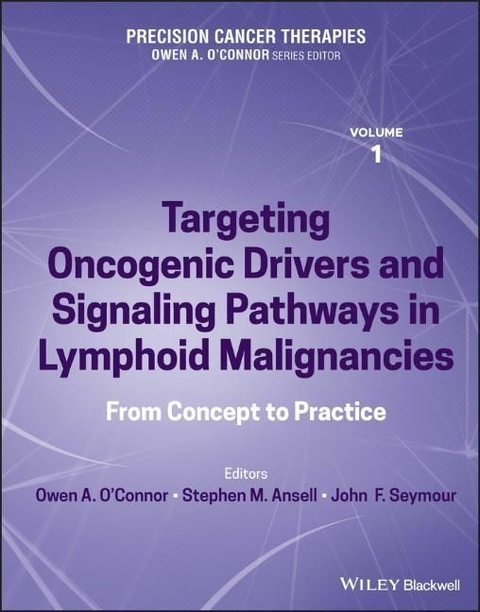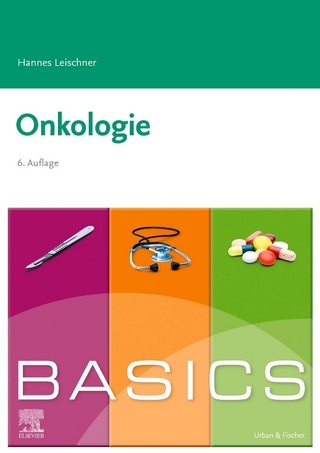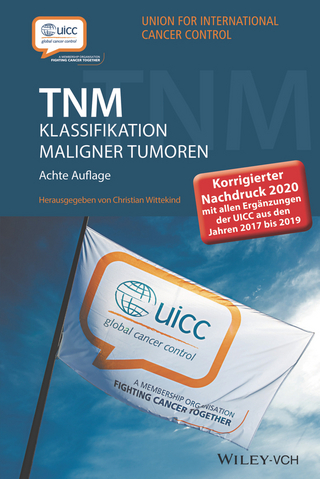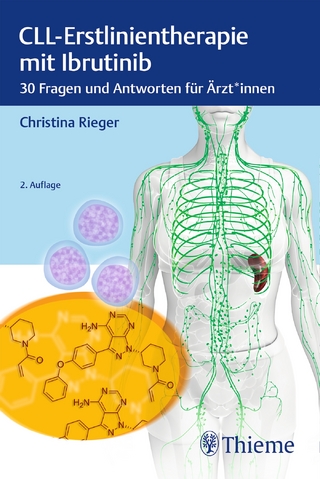
Targeting Oncogenic Drivers and Signaling Pathways in Lymphoid Malignancies
Wiley-Blackwell (Verlag)
978-1-119-81992-9 (ISBN)
The work primarily focuses on how to understand and translate fundamental principles of basic science into information that can be directly applied to patients – hence the subtitle, From Concept to Practice. To aid in readers’ comprehension, the first page of each chapter contains a box entitled ‘Take Home Points’. This short text will highlight the major unique points about the information contained within the chapter. Some of the key topics addressed in the work are as follows:
- Biological basis of the lymphoid malignancies: fundamental principles of lymphomagenesis and molecular classification of lymphoid malignancies
- Targeting programmed cell death: principles for understanding the many types of cell death and promising combinations of drugs targeting apoptosis
- Targeting the PI3K pathway: understanding the intricacies of this complex biology and precisely how targeted drugs can be leveraged therapeutically
- Targeting the cancer epigenome: pharmacologic features of drugs targeting the epigenome and future prospects for targeting various aspects of epigenetic control
- Targeting the tumour proteome: understanding the mechanisms of protein degradation in cancer including both older drugs like proteasome inhibitors, and newer PROTAC based approaches
Written primarily for scientists and physicians in both the public and private sectors, »Targeting Oncogenic Drivers and Signaling Pathways in Lymphoid Malignancies: From Concept to Practice« is a comprehensive reference work for those interested in the growing area of Precision Cancer Therapies. Seamlessly integrating the basic and applied science, this volume will be an indispensable reference for those interested in translating the most important advances in science to innovative novel treatments for patients.
Owen A. O’Connor, M.D., Ph.D. is an American Cancer Society Research Professor at the University of Virginia Comprehensive Cancer Center. He completed his training in Internal Medicine at the New York Presbyterian Hospital at Weill Cornell University Medical School, a Fellowship in Hematology and Oncology at Memorial Sloan Kettering Cancer Center and a Fellowship in Clinical Pharmacology at Weill Cornell. He has been recognized as one of the Top Physicians in Cancer in the U.S. and is recognized by the Irish Government as one of the top 50 Irish Americans in Science and Medicine.
Stephen M. Ansell, M.D., Ph.D. is the Dorotha W. and Grant L. Sundquist Professor of Hematologic Malignancies Research and the Chair of the Division of Hematology at Mayo Clinic. He received his medical degree from the University of Pretoria, South Africa and then completed a fellowship in Hematology and Medical Oncology at Mayo Clinic. His research focuses on optimizing antitumor immune function in B-cell malignancies. He received the Ernst Beutler Award from the American Society of Hematology in 2021 in recognition of his work.
John F. Seymour MBBS Ph.D. heads the Department of Haematology of the Peter MacCallum Cancer Centre & the Royal Melbourne Hospital and is Professor of Medicine at the University of Melbourne. He completed a translational research fellowship at the MD Anderson Cancer Center in Houston, and has received their Distinguished Alumnus award. His work is focused on new drug development in lymphoid malignancies. He was awarded Membership of the Order of Australia, and elected to the Australian Academy of Health and Medical Sciences for his contributions to the field.
Contents
List of Contributors xix
Volume Foreword xxiv
Volume Preface xxvi
Series Preface xxviii
Section I Biological Basis of the Lymphoid Malignancies 1
1 Fundamental Principles of Lymphomagenesis 3
Pierre Sujobert, Philippe Gaulard, and Laurence de Leval
Take Home Messages 3
Introduction 3
How to Study Lymphomagenesis 3
Before Lymphoma: The Gray Frontier Between Physiology and Pathology 5
The Cell of Origin Concept: A Classification Based on Physiology 6
What Are the Hallmarks of Lymphoma? 7
Conclusion 9
Must Read References 9
References 9
2 Identifying Molecular Drivers of Lymphomagenesis 12
Jennifer Shingleton and Sandeep S. Dave
Take Home Messages 12
Introduction 12
Sequencing and Bioinformatics Methods 13
Functional Validation of Drivers 13
Common Themes in B- and T-cell Lymphoma 14
Genetic Landscapes of Lymphomas 18
Genomic Subgrouping Approaches in DLBCL 19
Challenges of Incorporating Genomic Subgrouping Approaches in Clinical Trials 19
Leveraging Underlying Pathophysiology to Inform Therapeutic Consideration 20
Conclusion 22
Must Read References 22
References 22
3 Characterizing the Spectrum of Epigenetic Dysregulation Across Lymphoid Malignancies 25
Sean Harrop, Michael Dickinson, Ricky Johnstone, and Henry Miles Prince
Take Home Messages 25
Introduction: Epigenetics and Lymphoid Malignancies 25
Dysregulation of DNA Methylation and Modification of Histone Proteins 26
Genes Involved in Histone Modification Implicated in Lymphomagenesis 27
Genes Involved in DNA Methylation Implicated in Lymphomagenesis 27
The Epigenetic Landscape of Specific Lymphoid Malignancies 28
Summary 34
Must Read References 34
References 34
4 Animal Models of Lymphoid Malignancies 40
Anjali Mishra
Take Home Messages 40
Introduction 40
Optimal Animal Models to Study Lymphoid Neoplasms 41
Use of Animal Models in Translational Research 48
Conclusions 49
Must Read References 49
References 50
Section II Targeting the PI3 Kinase-AKT-mTOR Pathway 53
5 Principles of PI3K Biology and Its Role in Lymphoma 55
Ralitsa R. Madsen
Take Home Messages 55
Introduction: Overview 55
Four Decades of PI3K Signaling Research 55
Class I PI3K Enzymes 56
PI3K Pathway Effectors 59
Dynamic PI3K Signaling in Lymphocyte Biology 61
Lessons from Monogenic Disorders 64
Corrupted PI3K Signaling in Cancer 65
Concluding Remarks 67
Acknowledgments 67
Must Read Reference 67
References 67
6 Pharmacologic Differentiation of Drugs Targeting the PI3K-AKT-mTOR Signaling Pathway 71
Inhye E. Ahn, Jennifer R. Brown, and Matthew S. Davids
Take Home Messages 71
Introduction 71
PI3K Inhibitors Approved by the US Food and Drug Administration (FDA) 72
PI3K Inhibitors in Clinical Development 77
AKT Inhibitors 78
mTOR Inhibitors 79
Conclusions 79
Must Read References 79
References 80
7 Clinical Experience with Phosphatidylinositol 3-Kinase Inhibitors in Hematologic Malignancies 86
Alessandro Broccoli and Pier Luigi Zinzani
Take Home Messages 86
Introduction 86
Idelalisib 87
Copanlisib 91
Duvelisib 93
Umbralisib 95
Parsaclisib 97
Zandelisib 97
Amdizalisib (HMPL-689) 98
Conclusion 98
Must Read References 99
References 99
8 Clinical Experiences with Drugs Targeting mTOR 102
Thomas E. Witzig
Take Home Messages 102
Introduction 102
Rapamycin (Sirolimus) Rapamune® (Pfizer) and Generic Sirolimus 103
The Rapamycin Analogs (Rapalogs) 103
Temsirolimus (CCI-779; Torisel) 103
Everolimus (RAD-001; Afinitor, Zortrees, Evertor) 105
Summary of Lymphoma Studies of Everolimus 107
Ridaforolimus 108
Dual Inhibitors of mTORC1 and mTORC2 108
Side Effects of mTORC1 Inhibitors 108
Future Directions for mTOR Inhibitors in Lymphoma 109
Must Read References 110
References 110
9 PI3 Kinase, AKT, and mTOR Inhibitors 113
Joel McCay and John G. Gribben
Take Home Messages 113
Introduction 113
mTOR Inhibitors 116
PI3K and Dual PI3K/mTOR Inhibitors 116
PI3K Isoforms and Expression Throughout the Body 118
AKT Inhibitors 123
Conclusion 123
Must Read References 126
References 126
Section III Targeting Programmed Cell Death 131
10 Principles for Understanding Mechanisms of Cell Death and Their Role in Cancer Biology 133
Sarah T. Diepstraten, John E. La Marca, David C.S. Huang, and Gemma L. Kelly
Take Home Messages 133
Introduction 133
A Historical Perspective 133
Apoptotic Pathways 134
Other Cell Death Pathways 137
The Role of Intrinsic Apoptosis in Normal Cells – Lessons from Gene Knockout Mice 137
The Dysregulation of Apoptosis in Cancer 142
Must Read References 144
References 144
11 Pharmacologic Features of Drugs Targeting BCL2 Family Members 151
Jennifer K. Lue and Owen A. O’Connor
Take Home Messages 151
Introduction 151
Historical Perspective: From the Discovery of BCL2 to Therapeutic Applications 152
BCL2 as a Biomarker 153
Targeting BCL2 Family Members 154
Mechanisms of Resistance to BCL2 Inhibitors 158
Novel Mechanisms to Overcome BCL2 Resistance 159
Conclusions 160
Must Read References 161
References 161
12 Clinical Experience with Pro-Apoptotic Agents 165
Thomas E. Lew and John F. Seymour
Take Home Messages 165
Introduction 165
Safety and Toxicities of Pro-apoptotic Agents 166
Efficacy of Venetoclax in Chronic Lymphocytic Leukemia/Small Cell Lymphoma 168
Efficacy of Venetoclax in Other B-cell Neoplasms 173
Associations and Mechanisms of Resistance to Pro-apoptotic Agents 180
Must Read References 181
References 181
13 Promising Combinations of Drugs Targeting Apoptosis 186
William G. Wierda
Take Home Messages 186
Introduction: Background and Disease Perspective 186
Clinical Development of BCL2 Inhibitors 187
Venetoclax Monotherapy for CLL 187
Venetoclax Plus CD20 Monoclonal Antibody for CLL 190
Venetoclax Plus BTK Inhibitor for CLL 190
Venetoclax Plus BTK Inhibitor and CD20 Monoclonal Antibody for CLL 191
Venetoclax Plus Chemoimmunotherapy 191
Venetoclax Toxicities and Side Effects in CLL 192
Risk for Progression and Resistance Mechanisms 193
Current Knowledge Gaps and Opportunities for Future Work with Venetoclax 193
Must Read References 194
References 194
Section IV Targeting the Cancer Epigenome 197
14 The Role of Epigenetic Dysregulation in Lymphoma Biology 199
Qing Deng and Michael R. Green
Take Home Messages 199
Introduction: Germinal Center B (GCB)-cells and GCB-derived Lymphomas 199
Mutations Altering DNA Modifications and Structure 200
Mutations Altering Writers of Histone Post-translational Modifications 202
Mutations Altering Higher Order Chromatin Structure 204
Must Read References 206
References 206
15 Quantitating and Characterizing the Effects of Epigenetic Targeted Drugs 209
Emily Gruber, Alexander C. Lewis, and Lev M. Kats
Take Home Messages 209
Introduction 209
Experimental Analysis of the Epigenome 210
Molecular and Cellular Effects of Epigenetic Drugs 216
Concluding Remarks 221
Acknowledgments 221
Must Read References 221
References 221
16 Clinical Experience with Epigenetic Drugs in Lymphoid Malignancies 225
Enrica Marchi, Ipsita Pal, and John Sanil Manavalan
Take Home Messages 225
Introduction 225
Epigenome and Cancer 225
Different Epigenetic Classes of Drugs in Hematologic Malignancies 226
Summary 232
Must Read References 233
References 233
17 Future Prospects for Targeting the Epigenome in Lymphomas 236
Yusuke Isshiki and Ari Melnick
Take Home Messages 236
Introduction 236
Emerging Epigenetic Therapies 236
Precision Epigenetic Therapy 241
Maximizing the Impact of Emerging Epigenetic Therapies 242
Conclusions 244
Acknowledgments 244
Disclosures 244
Major Papers 244
Must Read References 244
References 244
Section V Targeting the B-cell Receptor (BCR) 249
18 The Pathologic Role of BCR Dysregulation in Lymphoid Malignancies 251
Jan A. Burger
Take Home Messages 251
Introduction: The BCR in Normal and Malignant B Lymphocytes 251
BCR Signaling 251
BCR Signaling in B-cell Malignancies 252
B-cell Proliferation in Secondary Lymphatic Organs (SLOs) 254
The BCR Complex in Malignant B-cells 255
BCR Signaling in DLBCL 256
Tonic BCR Signaling in Burkitt’s Lymphoma 257
BCR Signaling in Follicular Lymphoma (FL) 257
BCR Signaling in Mantle Cell Lymphoma (MCL) and Marginal Zone Lymphoma (MZL) 257
Targeting BCR Signaling 257
Bruton’s Tyrosine Kinase (BTK) Inhibitors 258
Ibrutinib 259
Acalabrutinib 259
BTK Inhibitors with Anti-CD20 Antibodies 259
Zanubrutinib 260
Pirtobrutinib 260
Idelalisib 260
Conclusions 260
Acknowledgments 261
Conflict of Interest 261
Must Read References 261
References 261
19 Pharmacologic Features of Drugs Targeting Bruton’s Tyrosine Kinase (BTK) 268
Joel McCay and John G. Gribben
Take Home Messages 268
Introduction 268
BTK and B-cell Activating Factor Receptor (BAFFR) Signaling 270
BTK in Cell Signaling Pathways 270
BTK Inhibitor Development and Mechanisms of Action 271
BTK Inhibitors in Malignancy 271
BTK Inhibitors in Solid Cancers 273
BTK Inhibitors in Autoimmune Diseases 273
Mechanisms of Resistance 273
Summary 273
Must Read References 274
References 274
20 Clinical Experience with Drugs Targeting Bruton’s Tyrosine Kinase (BTK) 278
Julia Aronson, Anthony R. Mato, Catherine C. Coombs, Prioty Islam, Lindsey E. Roeker, and Toby Eyre
Take Home Messages 278
Introduction: Chronic Lymphocytic Leukemia (CLL) 278
BTK Inhibition in Indolent B-cell non-Hodgkin’s Lymphoma 282
Mantle Cell Lymphoma (MCL) 282
Waldenstrom’s Macroglobulinemia (WM) 283
Marginal Zone Lymphoma (MZL) 283
CNS Involvement with B-cell Malignancies 283
Real-world Data 284
Conclusions 284
Must Read References 284
References 284
21 Promising Combinations of BTK Inhibitors with Other Targeted Agents 287
Nicholas J. Schmidt, Michael E. Williams, and Craig A. Portell
Take Home Messages 287
Introduction 287
Combinations of BTK Inhibitors and Targeted Drugs as the Standard of Care 288
The Future: Ongoing Clinical Trials and Additional BTKi Combinations of Interest 294
Conclusions 297
Must Read References 297
References 297
Section VI Protein Degraders and Membrane Transport Inhibitors 301
22 The Biological Basis for Targeting Protein Turnover in Malignant Cells 303
Robert Z. Orlowski
Take Home Messages 303
Introduction 303
Biological Basis for Targeting Protein Turnover 303
Immunomodulatory Drugs Affecting Protein Turnover 306
Conclusions 309
Acknowledgments 309
Must Read References 309
References 310
23 Preclinical Overview of Drugs Affecting Protein Turnover in Multiple Myeloma 313
Giada Bianchi, Matthew Ho, and Kenneth C. Anderson
Take Home Messages 313
Introduction 313
Overview of Protein Handling in MM 314
Molecular Chaperones in Protein Folding 314
Ubiquitin–Proteasome System (UPS) 314
Endoplasmic Reticulum (ER) Stress and the Unfolded Protein Response (UPR) 321
Autophagy and Aggresome Pathways 321
Targeting Nutrient Metabolism to Enhance Proteotoxic Stress 322
The Role of Proteasome Inhibition in the Era of Immunotherapy 323
Conclusions and Future Perspectives 323
Must Read References 324
References 324
24 Clinical Experience on Proteasome Inhibitors in Cancer 331
Noa Biran, Pooja Phull, and Andre Goy
Take Home Messages 331
Introduction to Proteasome Inhibitors (Pis) 331
Clinical Activity in Plasma Cell Disorders 333
Clinical Activity of Proteasome Inhibitors in Lymphoid Malignancies 338
Clinical Activity of Proteasome Inhibitors in AML/MDS 349
Clinical Activity of Proteasome Inhibitors in Solid Tumors 349
Overcoming Resistance to Proteasome Inhibitors in Cancer and Next Steps in Proteasome Inhibition 350
Must Read References 352
References 352
25 Targeting Nuclear Protein Transport with XPO Inhibitors in Lymphoma 361
Farheen Manji, Kyla Trkulja, Rob C. Laister, and John Kuruvilla
Take Home Messages 361
Introduction 361
XPO1 Biology 361
Pre-clinical and Clinical Data 362
Mechanisms of Intrinsic and Acquired Resistance to Selinexor and SINE Compounds 368
Future Directions 369
Must Read References 370
References 370
26 Heterobifunctional Degraders for the Treatment of Lymphoid Malignancies 372
Ashwin Gollerkeri, Jared Gollob, and Nello Mainolfi
Take Home Messages 372
Biology of Protein Degraders 372
Rationale for Use of Heterobifunctional Degraders in Oncology 373
Clinical Experience with Heterobifunctional Degraders 374
Development of Heterobifunctional Degraders in Lymphoma 375
Conclusions and Future Directions 378
Must Read References 378
References 378
Section VII Novel Targets and Therapeutic Prospects in Development 381
27 Strategies for Targeting the JAK-STAT Pathway in Lymphoid Malignancies 383
David J. Feith, Johnson Ung, Omar Elghawy, Peibin Yue, James Turkson, and Thomas P. Loughran Jr
Take Home Messages 383
JAK-STAT Signaling and Endogenous Regulators 383
Alternative Regulation and Function of STATs 385
Dysregulated Cytokine Signaling in Lymphoid Malignancies 386
Strategies to Target the JAK-STAT Pathway 387
Direct Targeting Approaches against STAT3 388
Clinical Trials of STAT3 Inhibitors in Lymphoid Malignancy 391
Targeting STAT5 in Lymphoid Malignancy 391
Clinical Trials of JAK Inhibitors in Lymphoid Malignancies 392
Challenges and Opportunities for Clinical Application of JAK-STAT Targeting Agents 395
Acknowledgments 396
Must Read References 396
References 396
28 Strategies for Targeting MYC 402
Jemma Longley and Andrew Davies
Take Home Messages 402
Introduction 402
Dysregulation of MYC in B-cell Lymphomas 403
Identifying MYC Rearrangement in the Context of HGBL 403
Targeting MYC Transcription 404
Targeting MYC Translation 405
Targeting MYC Stabilization and Downstream Gene Expression 406
Initial Therapy in MYC-R DLBCL 407
Future Directions 408
Must Read References 408
References 409
29 Targeting NOTCH in Lymphoid Malignancies 411
Deborah Piffaretti, Georgia Alice Galimberti, and Davide Rossi
Take Home Messages 411
Introduction: NOTCH Signaling 411
Role of NOTCH Signaling in B-cell 414
Genetic and Microenvironmental Mechanisms of NOTCH Signaling Alteration in CLL and Lymphomas 415
Other Genes of the Pathway (FBXW7, SPEN) 420
Inhibitors Tested at the Preclinical Level 420
Must Read References 421
References 421
30 Targeting NF-κB in Oncology, an Untapped Therapeutic Potential 428
Matko Kalac
Take Home Messages 428
Introduction 428
Historical Perspective for the Role of NF-κB in Malignancy 429
Canonical NF-κB Pathway 429
Non-canonical NF-κB Pathway 431
NF-κB in Tumorigenesis and Promotion of Malignant Cell Growth 431
Oncogenic Alterations in Lymphoma and Other Hematologic Malignancies 432
Role of NF-κB in Solid Malignancies 434
NF-κB Targeted Therapies 435
Summary 437
Must Read References 437
References 438
31 Targeting the Cell Cycle and Cyclin-dependent Kinases 444
Chiara Tarantelli and Francesco Bertoni
Take Home Messages 444
Introduction 444
CDK Family and Cyclins 444
CDKs Structure 446
CDKs Activation 446
CDKs Inhibition 446
CDKs Function 447
CDK-cyclin Deregulation in Cancer 448
Targeting CDKs in Lymphoid Malignancies 448
Resistance 451
Future Directions 451
Must Read References 452
References 452
Index 457
| Erscheinungsdatum | 05.05.2023 |
|---|---|
| Reihe/Serie | Precision Cancer Therapies ; 1 |
| Verlagsort | Hoboken |
| Sprache | englisch |
| Maße | 217 x 280 mm |
| Gewicht | 1616 g |
| Einbandart | gebunden |
| Themenwelt | Medizin / Pharmazie ► Medizinische Fachgebiete ► Onkologie |
| ISBN-10 | 1-119-81992-X / 111981992X |
| ISBN-13 | 978-1-119-81992-9 / 9781119819929 |
| Zustand | Neuware |
| Informationen gemäß Produktsicherheitsverordnung (GPSR) | |
| Haben Sie eine Frage zum Produkt? |
aus dem Bereich


